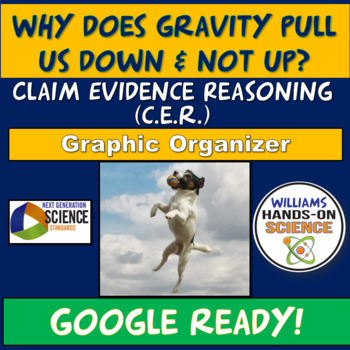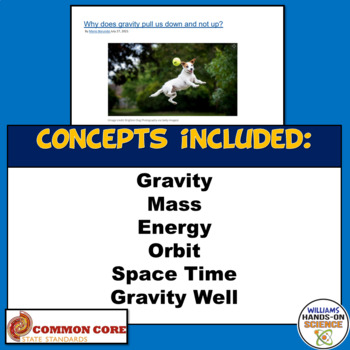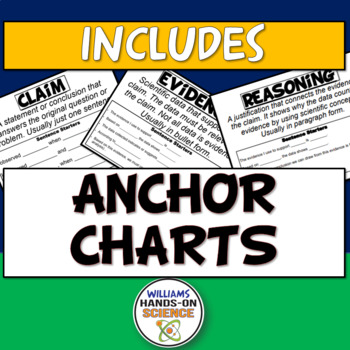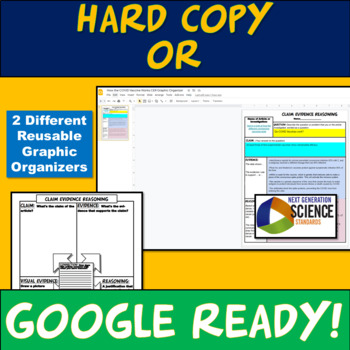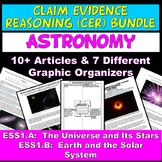Gravity Claim Evidence Reasoning CER NGSS ESS1.B PS2.B Print or Digital
- Zip
- Google Apps™

Also included in
- Students learn about various current events and discoveries in Astronomy through a C.E.R. (Claim Evidence Reasoning) graphic organizer. This is great for getting your students to explain phenomena in a meaningful way and it allows you as the instructor to adequately assess their understanding of conPrice $34.00Original Price $66.50Save $32.50
Description
Students learn why gravity always pulls down through a C.E.R. (Claim Evidence Reasoning) graphic organizer. This is great for getting your students to explain phenomena in a meaningful way and it allows you as the instructor to adequately assess their understanding of concepts. The students figure out what the "Claim" is in the article, they then use data that supports the claim in the "Evidence" section, draw visual evidence and then explain why the evidence supports the claim in the "Reasoning" section.
The article has the following concepts:
Gravity
Mass
Energy
Orbit
Space Time
Gravity Well
Take a look at my CER Mega bundle!
What you get with this resource:
-2 graphic organizer PDF's
-2 Google Ready graphic organizers
-Anchor chart to scaffold and support students with CER
-Article
-Google Classroom Tutorial
Related Products:
Solar System NGSS Claim Evidence Reasoning Mysterious Planet Nine Google Ready
Gravity & Solar System NGSS ESS1.A ESS1.B Online Simulation Google Ready
Gravity & Mass NGSS: MS-PS2-2 MS-PS2-4 5e Planning & Carrying Out Investigation
This is great for a current event, sub plan, homework, critical thinking, scaffolding and/or reinforcement of concepts!
You get a CER graphic organizer, an editable key, the article, tips for CER and the link to the website in the article.
NGSS for Middle School:
ESS1.B: Earth and the Solar System
•The solar system consists of the sun and a collection of objects, including planets, their moons, and asteroids that are held in orbit around the sun by its gravitational pull on them. (MS-ESS1-2), (MS-ESS1-3)
•The solar system appears to have formed from a disk of dust and gas, drawn together by gravity. (MS-ESS1-2)
PS2.B: Types of Interactions
•Forces that act at a distance (electric, magnetic, and gravitational) can be explained by fields that extend through space and can be mapped by their effect on a test object (a charged object, or a ball, respectively). (MS-PS2-5)
•Electric and magnetic (electromagnetic) forces can be attractive or repulsive, and their sizes depend on the magnitudes of the charges, currents, or magnetic strengths involved and on the distances between the interacting objects. (MS-PS2-3)
•Gravitational forces are always attractive. There is a gravitational force between any two masses, but it is very small except when one or both of the objects have large mass—e.g., Earth and the sun. (MS-PS2-4)
NGSS for High School:
PS2.B: Types of Interactions
•Newton’s law of universal gravitation and Coulomb’s law provide the mathematical models to describe and predict the effects of gravitational and electrostatic forces between distant objects. (HS-PS2-4)
•Forces at a distance are explained by fields (gravitational, electric, and magnetic) permeating space that can transfer energy through space. Magnets or electric currents cause magnetic fields; electric charges or changing magnetic fields cause electric fields. (HS-PS2-4), (HS-PS2-5)
NGSS Standards:
SEP's Asking Questions and Defining Problem:
Students at any grade level should be able to ask questions of each other about the texts they read, the features of the phenomena they observe, and the conclusions they draw from their models or scientific investigations.
Engaging in Argument from Evidence:
In 9–12 builds on K–8 experiences and progresses to using appropriate and sufficient evidence and scientific reasoning to defend and critique claims and explanations about the natural and designed world(s). Arguments may also come from current scientific or historical episodes in science.
CCC's: Patterns
Observed patterns of forms and events guide organization and classification, and they prompt questions about relationships and the factors that influence them.
TERMS OF USE
• All rights reserved by Williams Hands On Science, Inc.
• This product is to be used by the original purchaser only.
• Intended for classroom and personal use only.
• Copying for more than one teacher, classroom, department, school, or school system is prohibited.
• This product may not be distributed or displayed digitally for public view.
• Failure to comply is a copyright infringement and a violation of the Digital Millennium Copyright Act (DMCA).
If there are any errors or questions, please contact me through TpT or email me at:
williamshandsonscience@gmail.com
Thank you for taking a look!
Please follow me on TpT for new products and check me out on Instagram for my products in action!

